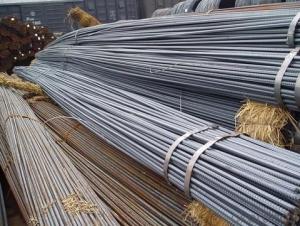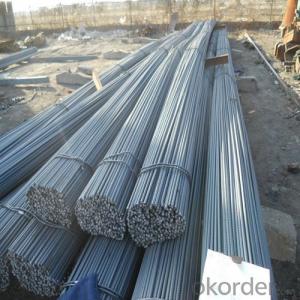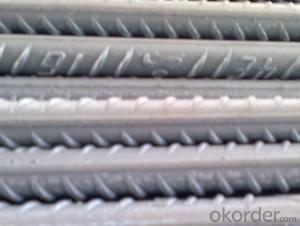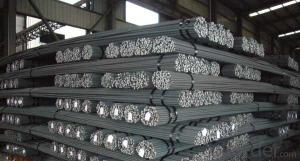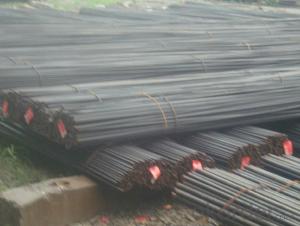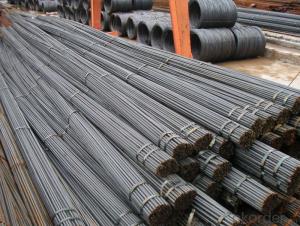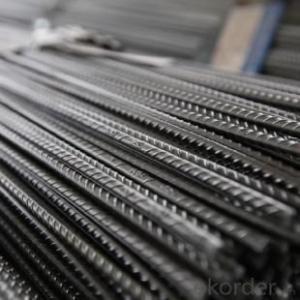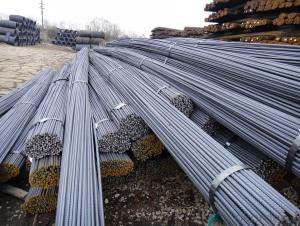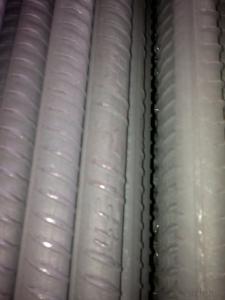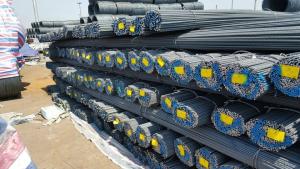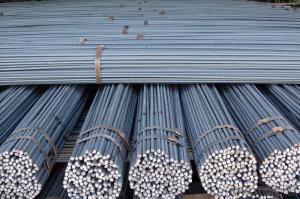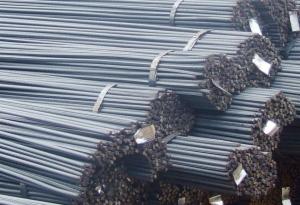GB Standard HRB400 Steel Deformed Bar 14mm/16mm
- Loading Port:
- Tianjin
- Payment Terms:
- TT or LC
- Min Order Qty:
- 25 m.t
- Supply Capability:
- 20000 m.t/month
OKorder Service Pledge
OKorder Financial Service
You Might Also Like
GB Standard HRB400 Steel Deformed Bar 14mm/16mm
Description:
-Standard: GB
-Material: HRB400
-Specification:
| Diameter(mm) | Section Area(mm2) | Mass(Kg/m) | Length(m) |
| 14 | 153.9 | 1.21 | 9, 12 or as customs' request |
| 16 | 201.1 | 1.58 | 9, 12 or as customs' request |
Chemical Composition(%) of GB Standard HRB400 Steel Deformed Bar 14mm/16mm:
| C | Mn | Si | S | P | V |
| ≤0.25 | ≤1.60 | ≤0.08 | ≤0.045 | ≤0.045 | 0.04-0.12 |
Mechanical Properties of GB Standard HRB400 Steel Deformed Bar 14mm/16mm:
Yield Strength (N/cm²) | Tensile Strength (N/cm²) | Elongation (%) |
≥400 | ≥570 | ≥14 |
Usage and Applications of GB Standard HRB400 Steel Deformed Bar 14mm/16mm:
Deformed bar is widely used in buildings, bridges, roads and other engineering construction. Big to highways, railways, bridges, culverts, tunnels, public facilities such as flood control, dam, small to housing construction, beam, column, wall and the foundation of the plate, deformed bar is an integral structure material. With the development of world economy and the vigorous development of infrastructure construction, real estate, the demand for deformed bar will be larger and larger.
Packaging & Delivery of GB Standard HRB400 Steel Deformed Bar 14mm/16mm:
Packaging Detail: products are packed in bundle and then shipped by container or bulk vessel, deformed bar is usually naked strapping delivery, when storing, please pay attention to moisture proof. The performance of rust will produce adverse effect.
Each bundle weight: 2-3MT, or as required
Payment term: TT or L/C
Delivery Detail: within 45 days after received advanced payment or LC.
Label: to be specified by customer, generally, each bundle has 1-2 labels
Trade terms: FOB, CFR, CIF
Images of GB Standard HRB400 Steel Deformed Bar 14mm/16mm:
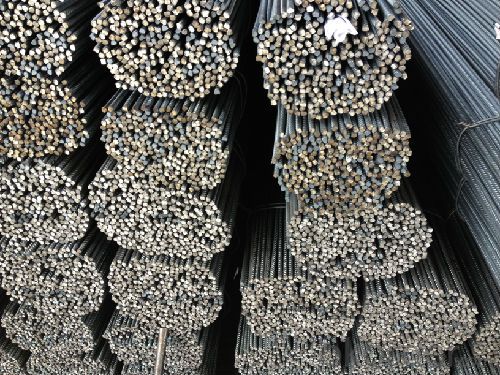
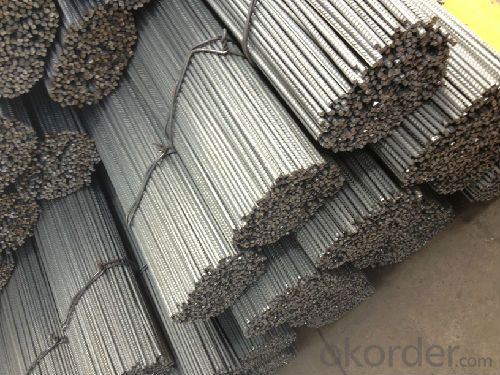
*If you would like to get our price, please inform us the size, standard/material and quantity. Thank you very much for your attention.
- Q: What is the purpose of ribbed steel rebars?
- The purpose of ribbed steel rebars is to provide reinforcement and enhance the strength of concrete structures, such as buildings, bridges, and roads. The ribs on the rebar increase the bond between the steel and concrete, preventing slippage and improving the overall structural integrity.
- Q: Are there any health or safety concerns associated with steel rebars?
- Yes, there are potential health and safety concerns associated with steel rebars. Some of the concerns include physical injuries from handling and working with heavy steel bars, such as cuts, bruises, and strains. Additionally, exposure to steel dust or fumes during cutting, welding, or grinding processes can pose respiratory hazards. It is important to follow proper safety protocols, such as wearing personal protective equipment, ensuring proper ventilation, and using appropriate tools, to minimize these risks.
- Q: What is the role of steel rebars in tunnel lining construction?
- The role of steel rebars in tunnel lining construction is to reinforce the concrete structure and provide added strength and durability. They help distribute the load and prevent cracks or collapses, ensuring the stability and long-term integrity of the tunnel.
- Q: Can steel rebars be used in the construction of data centers and server rooms?
- Yes, steel rebars can be used in the construction of data centers and server rooms. Steel rebars provide structural reinforcement and can be used in the construction of walls, columns, and foundations. They help to enhance the overall strength and durability of the building, ensuring the safety and stability of the data center or server room infrastructure.
- Q: What are the guidelines for proper splicing of steel rebars in concrete structures?
- The guidelines for proper splicing of steel rebars in concrete structures are essential to ensure the structural integrity and safety of the building. Here are some key guidelines to follow: 1. Length of Lap Splicing: The length of lap splicing refers to the overlapping distance between two rebars. It is crucial to follow the specified length mentioned in the design plans or structural codes. Typically, the minimum lap length for rebars is specified as a certain multiple of their diameter, such as 40 times the diameter for tension members and 25 times the diameter for compression members. 2. Cleanliness: Before splicing the rebars, the surfaces of the bars must be cleaned thoroughly to remove any rust, scale, dirt, or other contaminants. Proper cleaning ensures a strong bond between the bars during the splicing process. 3. Proper Alignment: The rebars being spliced should be properly aligned to maintain the continuity of the reinforcement. Misalignment can lead to stress concentration, weakening the overall structure. The bars should be aligned in a straight line, ensuring that they are parallel and evenly spaced. 4. Splice Type: There are various types of splice connections available, such as lap splicing, mechanical splicing, and welded splicing. The choice of splice type should be based on the specific project requirements, structural design, and local building codes. 5. Reinforcement Bar Preparation: The rebars need to be prepared before splicing by removing any scale, rust, or other contaminants. This can be done through brushing, grinding, or shot blasting. Additionally, the ends of the rebars should be clean and free of any deformations or irregularities. 6. Testing and Inspection: It is crucial to conduct regular testing and inspection to ensure the quality and integrity of the spliced rebars. Non-destructive testing methods, such as ultrasound or magnetic particle testing, can be employed to check the bond strength and ensure the splicing has been done correctly. 7. Adequate Cover: The spliced rebars must have adequate concrete cover to protect them from corrosion and fire. The thickness of concrete cover should comply with the local building codes and design specifications. 8. Proper Grouting: If mechanical splices are used, it is important to ensure proper grouting or filling of the splice sleeve or coupler with an approved non-shrink grout. This helps in achieving full load transfer and prevents any movement or slippage of the rebars. 9. Documentation: All splicing activities should be properly documented, including the type of splice used, lap lengths, inspection reports, and any deviations from the original design. This documentation is important for future reference, maintenance, and to ensure compliance with regulatory agencies. It is important to note that these guidelines are general recommendations, and specific project requirements and local building codes should always be followed for proper splicing of steel rebars in concrete structures. Consulting with a qualified structural engineer or following the advice of a reputable construction professional is crucial to ensure the highest standards of safety and compliance.
- Q: What are the advantages of using epoxy-coated stainless steel rebars?
- Epoxy-coated stainless steel rebars offer a variety of benefits. Firstly, the addition of epoxy coating enhances the rebars' corrosion resistance by acting as a barrier against moisture, chemicals, and other corrosive elements. This extends the rebars' lifespan and ensures the durability of the structure. Secondly, the epoxy coating improves the bond strength between the rebar and concrete by creating a rough surface texture. This results in a stronger overall structure. Another advantage is that the epoxy coating provides a smooth surface, making the rebars easier to handle and install during construction. It also eliminates the risk of injury from sharp edges. Furthermore, epoxy-coated stainless steel rebars are environmentally friendly as they do not contain harmful substances like lead or heavy metals. This makes them a sustainable choice for environmentally conscious projects. Lastly, these rebars require minimal maintenance due to the protective layer provided by the epoxy coating. This saves time, costs, and minimizes disruptions to ongoing construction projects. In conclusion, the benefits of using epoxy-coated stainless steel rebars include enhanced corrosion resistance, improved bond strength, ease of handling and installation, environmental friendliness, and reduced maintenance requirements. These advantages make them a reliable and cost-effective choice for reinforcing concrete structures.
- Q: Can steel rebars be used in structures with limited construction space?
- Yes, steel rebars can be used in structures with limited construction space. Steel rebars are versatile and can be easily maneuvered and placed in confined spaces. They are commonly used in construction projects with limited space, such as high-rise buildings, underground structures, and bridges. Their flexibility and strength make them a suitable choice for reinforcing concrete structures in tight construction areas.
- Q: What is the process of cutting and bending steel rebars on-site?
- The process of cutting and bending steel rebars on-site typically involves the use of specialized tools such as rebar cutters and benders. First, the required length of rebar is measured and marked. Then, the rebar cutter is used to accurately cut the rebar to the desired length. Next, if any bends or shapes are required, the rebar is placed in the bending machine, which applies pressure to bend it accordingly. This process ensures that the steel rebars are tailored to fit the specific construction needs on-site.
- Q: What is the process of inspecting steel rebars for quality control?
- The process of inspecting steel rebars for quality control involves several steps to ensure that the rebars meet the required standards and specifications. Here is a general overview of the process: 1. Visual Inspection: The first step is to visually inspect the rebars for any visible defects such as cracks, surface imperfections, or irregularities in shape or size. This can be done manually or using automated systems that detect defects through image processing techniques. 2. Measurement and Dimensional Inspection: The rebars are then measured for their dimensions, including length, diameter, and shape. This is typically done using calibrated measuring instruments such as calipers, gauges, or laser-based devices. The measurements are compared against the specified tolerances to ensure compliance. 3. Chemical Analysis: A sample of rebars is taken and subjected to chemical analysis to determine the composition of the steel. This includes measuring the levels of carbon, manganese, sulfur, phosphorus, and other elements. The results are compared against the required chemical composition specified in the standards. 4. Mechanical Testing: Mechanical properties such as tensile strength, yield strength, elongation, and bendability are crucial for rebars used in construction. Samples are taken from the batch and tested in a laboratory using standardized tests, such as tensile testing machines, to ensure they meet the specified requirements. 5. Corrosion Resistance Testing: Rebars are often exposed to harsh environmental conditions, so it is important to assess their resistance to corrosion. This can be done through tests like salt spray testing or electrochemical methods to measure the rebars' corrosion resistance and ensure they will maintain their strength over time. 6. Weldability Testing: If rebars are intended for welding applications, their weldability is assessed. This includes evaluating the rebars' ability to form a strong and sound weld joint without any defects. Weldability tests may involve visual inspection, bend tests, or even destructive testing of welded samples. 7. Documentation and Certification: Throughout the inspection process, detailed records of all measurements, test results, and observations are documented. If the rebars pass all quality control tests, a certification or quality control report is issued, indicating that the rebars meet the required standards and specifications. It is worth noting that the specific inspection procedures may vary depending on the applicable standards, project requirements, and the type of rebar being inspected. Additionally, these inspections can be conducted by internal quality control teams or independent third-party inspection agencies to ensure impartiality and accuracy of the results.
- Q: How do steel rebars prevent cracks in concrete?
- The reinforcement provided by steel rebars is essential for preventing cracks in concrete. These rebars increase the tensile strength of the concrete, which is weak in tension. While concrete can withstand compressive forces, it is susceptible to cracking when subjected to tension or pulling forces. When steel rebars are embedded in concrete, they function as a framework or skeleton that distributes the tensile forces evenly throughout the structure. As a result, the rebars absorb the tension, effectively preventing the concrete from cracking or failing under the applied load. In addition to absorbing tension, the rebars also control the size and width of any cracks that may occur. By confining the cracks to a limited area surrounding the rebars, they prevent the cracks from spreading throughout the entire concrete structure. Furthermore, the presence of rebars can even help prevent cracks from forming in the first place, as they reinforce the concrete and improve its overall durability. To summarize, steel rebars play a critical role in preventing cracks in concrete by increasing its tensile strength, absorbing tension, and controlling crack propagation. This reinforcement is vital in ensuring the structural integrity and longevity of concrete structures, effectively preventing potential failures and ensuring their safety.
Send your message to us
GB Standard HRB400 Steel Deformed Bar 14mm/16mm
- Loading Port:
- Tianjin
- Payment Terms:
- TT or LC
- Min Order Qty:
- 25 m.t
- Supply Capability:
- 20000 m.t/month
OKorder Service Pledge
OKorder Financial Service
Similar products
Hot products
Hot Searches
Related keywords
